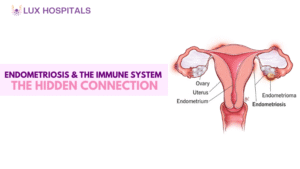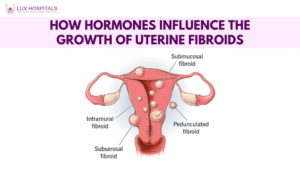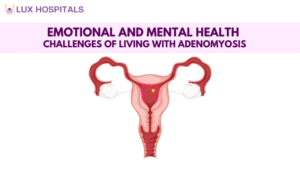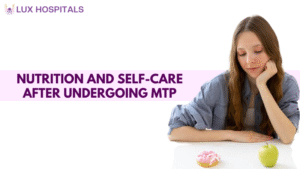14 Common PMS Symptoms: Powerful Tips to Ease Discomfort

Introduction
Do you ever wonder why certain days of the month feel like an emotional rollercoaster? From sudden mood swings to that stubborn bloating, you’re not alone—millions of women experience the same PMS symptoms every month.
Brief Introduction to PMS:
Premenstrual syndrome, commonly known as PMS, refers to a combination of emotional, physical, and psychological symptoms that many women experience in the days leading up to their period. It’s caused by the hormonal fluctuations that occur during the menstrual cycle.
In fact, up to 75% of women report experiencing PMS symptoms at some point in their reproductive lives. While for some, these symptoms may be mild, others may face severe discomfort that interferes with their daily activities, work, and relationships.
In this blog, we’ll take a closer look at the most common symptoms of PMS, how they manifest, and what can be done to manage them, helping you understand your body better and take control of your well-being.
What is PMS?
Premenstrual Syndrome (PMS) is a group of physical, emotional, and behavioral symptoms that women experience in the days leading up to their menstrual period. These symptoms typically occur during the luteal phase of the menstrual cycle (after ovulation and before menstruation) and can last anywhere from a few days to two weeks. The severity and types of symptoms vary, but they generally go away after the period begins.
Hormonal Changes Behind PMS:
PMS is closely linked to the hormonal changes that occur in a woman’s body throughout her menstrual cycle, particularly the fluctuations in estrogen and progesterone. After ovulation, progesterone levels rise while estrogen levels drop, preparing the body for a potential pregnancy. If pregnancy doesn’t occur, both hormone levels drop sharply just before menstruation begins, triggering PMS symptoms
In addition to estrogen and progesterone, the brain’s neurotransmitters—particularly serotonin—are also affected by these hormonal shifts. Serotonin is responsible for mood regulation, so when its levels drop during PMS, women may experience mood swings, irritability, and depression.
How PMS Differs Among Women:
PMS can vary widely from one woman to another. Some women may experience only mild symptoms, such as slight bloating or moodiness, while others may suffer from severe symptoms, including intense cramping, headaches, and emotional distress. The degree to which PMS affects women can depend on several factors, such as genetics, lifestyle, and overall health. For some, PMS may even be severe enough to be classified as Premenstrual Dysphoric Disorder (PMDD), a more extreme form of PMS that significantly impacts day-to-day functioning.
Physical Symptoms of PMS

1. Bloating
Bloating during PMS is a common symptom caused by hormonal changes, specifically the rise in progesterone levels. This hormone causes the body to retain water and salt, leading to a feeling of fullness or puffiness in the abdomen. Bloating can make clothes feel tighter and cause general discomfort.
2. Breast Tenderness
Breast tenderness occurs due to the fluctuations in estrogen and progesterone leading up to menstruation. These hormones cause the breast tissue to swell, resulting in tenderness or a feeling of heaviness. Some women may also experience swollen or lumpy breasts during this time.
3. Headaches and Migraines
Hormonal changes, particularly the drop in estrogen just before menstruation, can trigger headaches and migraines in some women. These headaches can vary in intensity, with some experiencing mild discomfort and others suffering from severe migraines.
4. Fatigue
Feeling unusually tired during PMS is common and is often linked to the body’s hormonal fluctuations. Low levels of serotonin and progesterone can lead to feelings of lethargy, reduced energy, and difficulty staying alert.
5. Cramps (Abdominal Pain)
Cramps, also known as dysmenorrhea, occur when the uterus contracts to help shed its lining during menstruation. These contractions are triggered by prostaglandins, hormone-like substances that cause inflammation and pain in the lower abdomen. Cramps can vary in intensity, from mild discomfort to severe pain.
6. Changes in Appetite
Hormonal shifts can cause noticeable changes in appetite, leading to food cravings (often for carbohydrates or sweets) or even a loss of appetite. These cravings are linked to changes in serotonin levels, which affect mood and appetite regulation.
7. Acne
Acne breakouts during PMS are caused by the increase in androgens, hormones that boost oil production in the skin. This excess oil clogs pores, leading to pimples or acne flare-ups, especially on the face, chest, and back.
8. Back Pain
Lower back pain during PMS can occur due to the uterine contractions associated with cramps. These contractions can radiate pain to the lower back and hips, causing discomfort in the days leading up to menstruation. This symptom is more common in women who experience severe menstrual cramps.
Emotional and Behavioral Symptoms of PMS
1. Mood Swings
One of the most well-known emotional symptoms of PMS is mood swings. Hormonal changes, particularly fluctuations in estrogen and progesterone, can cause sudden shifts in mood. Women may feel irritable, emotional, or experience highs and lows without any clear trigger, making it difficult to maintain emotional balance during this time.
2. Anxiety and Tension
Increased levels of stress or nervousness are common in the days leading up to menstruation. The hormonal imbalance can affect neurotransmitters like serotonin, causing heightened feelings of anxiety and tension, even in situations that might not usually be stressful.
3. Depression
Some women may experience mild to moderate depression during PMS, characterized by feelings of sadness, hopelessness, or low self-worth. This emotional dip is also linked to the drop in serotonin, which is responsible for maintaining mood stability. While these feelings usually subside after menstruation begins, they can be distressing during PMS.
4. Difficulty Concentrating
Many women report trouble focusing or remembering things during PMS. This is known as “brain fog” and is tied to the hormonal shifts that impact cognitive functions. Women may find it hard to concentrate on tasks or feel forgetful during this phase of the menstrual cycle.
5. Sleep Disturbances
Sleep patterns can be disrupted due to PMS, with some women experiencing insomnia (difficulty falling or staying asleep) or, conversely, excessive sleepiness. Hormonal fluctuations can interfere with the body’s circadian rhythm, making it challenging to maintain a consistent sleep schedule.
6. Social Withdrawal
PMS can cause some women to feel the urge to isolate themselves or avoid social interactions. Emotional symptoms like irritability, sadness, or anxiety may lead them to withdraw from family, friends, or social activities during this time. This is often a coping mechanism for dealing with the emotional rollercoaster of PMS.
Why PMS Symptoms Occur
Hormonal Changes During the Menstrual Cycle
PMS symptoms are primarily driven by the natural hormonal fluctuations that occur throughout the menstrual cycle. The cycle has two main phases: the follicular phase (before ovulation) and the luteal phase (after ovulation). PMS typically occurs during the luteal phase, when the body is preparing for a potential pregnancy.
Role of Estrogen and Progesterone
After ovulation, the levels of progesterone rise to prepare the uterus for a possible pregnancy, while estrogen levels gradually decline. If pregnancy doesn’t occur, both estrogen and progesterone levels drop sharply, triggering the onset of PMS symptoms. This hormonal imbalance affects mood-regulating chemicals like serotonin, leading to emotional and physical symptoms such as mood swings, irritability, and fatigue.
Other Contributing Factors
- Diet: A poor diet, especially one high in salt, sugar, or caffeine, can worsen symptoms like bloating, mood swings, and fatigue.
- Lifestyle: Lack of exercise and insufficient sleep can also intensify PMS symptoms. Exercise helps balance hormones and enhances mood.
- Stress: High stress levels can make PMS symptoms more severe by affecting hormone regulation and overall emotional well-being. Stress impacts the production of cortisol, which can interfere with other hormones and exacerbate symptoms like anxiety and tension.
These combined factors—hormonal changes and lifestyle habits—determine the severity and type of PMS symptoms a woman may experience each month.
Managing PMS Symptoms
1. Diet and Nutrition
What you eat can significantly impact PMS symptoms. To alleviate discomfort, focus on a balanced diet that includes:
- Complex carbohydrates (like whole grains and vegetables) to stabilize blood sugar levels and reduce mood swings.
- Foods rich in magnesium, such as leafy greens, nuts, and seeds, to help ease muscle cramps and anxiety.
- Low-sodium foods to prevent bloating and water retention.
- Healthy fats (like those found in avocados and olive oil) to support hormone balance.
- Avoid caffeine, alcohol, and excessive sugar, as these can worsen symptoms like bloating, irritability, and fatigue.
2. Exercise
Regular physical activity can be highly effective in reducing PMS symptoms. Exercise helps by:
- Boosting endorphins, which improve mood and act as natural painkillers, reducing cramps and emotional symptoms.
- Improving blood circulation, which can alleviate bloating and fatigue.
- Reducing stress, thereby lessening the emotional impact of PMS.
Even light activities like walking, swimming, or yoga can make a difference.
3. Sleep
Adequate rest is crucial for managing PMS. Hormonal changes can disrupt sleep, so it’s important to:
- Aim for 7–9 hours of sleep per night to help the body recover and regulate hormones.
- Maintain a consistent sleep schedule to minimize fatigue and irritability.
- Create a relaxing bedtime routine, such as reading or meditating, to help combat insomnia.
4. Medications
For women with more severe PMS symptoms, medications can offer relief:
- Over-the-counter pain relievers, such as ibuprofen or naproxen, can help reduce cramps, headaches, and back pain.
- Oral contraceptives are sometimes prescribed to regulate hormone levels and lessen the intensity of PMS symptoms.
- In more extreme cases, doctors may prescribe antidepressants (SSRIs) to help balance mood and reduce emotional symptoms, such as anxiety and depression.
5. Stress Management
Managing stress can greatly reduce PMS symptoms, particularly the emotional ones. Effective methods include:
- Meditation and deep breathing exercises, which help calm the mind and reduce anxiety.
- Yoga, which combines physical activity with stress relief, making it effective for both cramps and mood regulation.
- Progressive muscle relaxation, which helps reduce muscle tension associated with PMS discomfort.
Incorporating these practices into daily life can help minimize both the physical and emotional effects of PMS.
When to See a Doctor
1. Irregular Periods
If you experience significant irregularities in your menstrual cycle, such as:
- Not having your period on time or missing periods altogether.
- Periods lasting longer than usual, or having unusually heavy or prolonged bleeding.
These irregularities can indicate underlying issues that may need medical attention, such as hormonal imbalances, polycystic ovary syndrome (PCOS), or other gynecological conditions.
2. PMS vs. PMDD
While PMS affects many women, Premenstrual Dysphoric Disorder (PMDD) is a more severe form that can significantly disrupt daily life. PMDD symptoms are similar to PMS but are more intense and include:
- intense mood swings, such as depression, anxiety, and irritability.
- Extreme physical symptoms, such as debilitating cramps, migraines, or joint pain.
- Interference with daily activities, making it difficult to perform at work, maintain relationships, or engage in normal activities.
If symptoms are severe and impact your quality of life, it’s essential to consult a healthcare provider to determine if you may have PMDD or another condition that requires specialized treatment.
3. Seek Medical Advice
It’s important to seek medical advice if:
- Symptoms are interfering with daily life, causing significant discomfort or emotional distress.
- Over-the-counter treatments or lifestyle changes are not providing relief.
- You experience new or unusual symptoms that do not align with your typical PMS patterns.
Consulting a healthcare provider can help diagnose any underlying issues, recommend appropriate treatments, and provide strategies for managing symptoms effectively.
Conclusion
Understanding and managing PMS symptoms is key to improving your quality of life. By recognizing the physical and emotional signs, and utilizing strategies like proper diet, exercise, and stress management, you can alleviate many of the discomforts associated with PMS.
If you find that your symptoms are severe or affecting your daily life, don’t hesitate to seek professional advice. At Lux Hospitals in Hyderabad, our specialists are here to provide support and personalized care to help you manage your PMS effectively.
For expert guidance and treatment options, contact Lux Hospitals today. Let us help you take control of your health and well-being.
Frequently Asked Questions
Common PMS symptoms include mood swings, bloating, breast tenderness, headaches, fatigue, cramps, changes in appetite, acne, and back pain.
PMS symptoms typically begin in the luteal phase of the menstrual cycle (about 1–2 weeks before menstruation) and usually end once menstruation starts or shortly thereafter.
Managing severe PMS symptoms may involve lifestyle changes such as improved diet, regular exercise, better sleep, and stress management. Over-the-counter pain relievers, hormonal treatments, or antidepressants may also be recommended by a healthcare provider.
Consult a doctor if your PMS symptoms are severe, interfere significantly with your daily life, or if you experience irregular menstrual cycles or symptoms that don’t match your typical PMS patterns.
PMS (Premenstrual Syndrome) includes a range of symptoms that affect many women before their period. PMDD (Premenstrual Dysphoric Disorder) is a more severe form of PMS with intense emotional and physical symptoms that significantly impact daily functioning.
Yes, maintaining a balanced diet and regular physical activity can help alleviate many PMS symptoms. Eating foods rich in magnesium, fiber, and healthy fats and engaging in regular exercise can improve mood, reduce cramps, and decrease bloating.




















